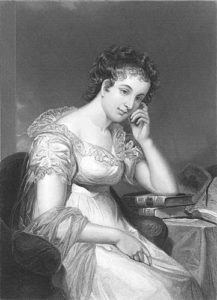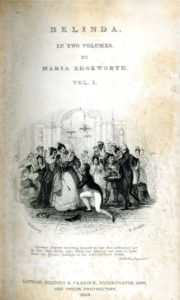Bad Plots and Objectivity in Maria Edgeworth
by Yoon Sun Lee
The essay begins:
 Maria Edgeworth (1767–1849) is famous for her bad plots. A contemporary reviewer of her 1814 novel Patronage complains that “the story is always the worst part of Miss Edgeworth’s novel.” There she consistently proves “inferior . . . to many of those that are vastly below her in everything else.” This backhanded compliment to a novelist publicly admired by Jane Austen and Sir Walter Scott may suggest some of the reasons that Edgeworth has fallen into neglect. Despite her popularity and widespread readership in her lifetime, particularly in nineteenth-century America, this Anglo-Irish writer of national tales and novels never fully entered the literary canon. If read at all, Edgeworth’s novels are studied in relation to questions of Irish identity and history, rather than as examples of the genre’s possibilities. This may indeed be attributable to a certain quality that many of her plots possess. In their broad outlines, they are unobjectionable, if not exciting. Their protagonists, whether old or young, male or female, aristocratic or working class, must learn to choose for themselves the way of life most productive of happiness. They need to overcome prejudice, indolence, misdirected sympathies, and unhealthy influences. The alleged badness of her plots, then, does not concern any unfamiliarity of outline. Nor does it derive from over-reliance on arbitrary events, chance encounters, or coincidences. Though these can certainly be found in Edgeworth’s plots, sometimes concentrated toward the end, they are arguably standard features of narrative and certainly of the novel by 1800. Rather, it seems that Edgeworth’s “carelessness” has to do with not sufficiently disguising the epistemological responsibilities placed on fictional plot by the development of experimental science. Her plots usually tell the story of how characters learn to think rationally. But this requires more than learning to distinguish between truth and lies, genuine and false stories or feelings. As one character in her novel Belinda (1801) puts it, “Our reasonings as to the conduct of life . . . must depend ultimately on facts.” For Edgeworth, then, plot becomes the means of producing legitimately objective facts within a fictive universe. In a twist in the dialectic of fictionality, plot has to produce a hierarchy of epistemological certainty within its own orderings.
Maria Edgeworth (1767–1849) is famous for her bad plots. A contemporary reviewer of her 1814 novel Patronage complains that “the story is always the worst part of Miss Edgeworth’s novel.” There she consistently proves “inferior . . . to many of those that are vastly below her in everything else.” This backhanded compliment to a novelist publicly admired by Jane Austen and Sir Walter Scott may suggest some of the reasons that Edgeworth has fallen into neglect. Despite her popularity and widespread readership in her lifetime, particularly in nineteenth-century America, this Anglo-Irish writer of national tales and novels never fully entered the literary canon. If read at all, Edgeworth’s novels are studied in relation to questions of Irish identity and history, rather than as examples of the genre’s possibilities. This may indeed be attributable to a certain quality that many of her plots possess. In their broad outlines, they are unobjectionable, if not exciting. Their protagonists, whether old or young, male or female, aristocratic or working class, must learn to choose for themselves the way of life most productive of happiness. They need to overcome prejudice, indolence, misdirected sympathies, and unhealthy influences. The alleged badness of her plots, then, does not concern any unfamiliarity of outline. Nor does it derive from over-reliance on arbitrary events, chance encounters, or coincidences. Though these can certainly be found in Edgeworth’s plots, sometimes concentrated toward the end, they are arguably standard features of narrative and certainly of the novel by 1800. Rather, it seems that Edgeworth’s “carelessness” has to do with not sufficiently disguising the epistemological responsibilities placed on fictional plot by the development of experimental science. Her plots usually tell the story of how characters learn to think rationally. But this requires more than learning to distinguish between truth and lies, genuine and false stories or feelings. As one character in her novel Belinda (1801) puts it, “Our reasonings as to the conduct of life . . . must depend ultimately on facts.” For Edgeworth, then, plot becomes the means of producing legitimately objective facts within a fictive universe. In a twist in the dialectic of fictionality, plot has to produce a hierarchy of epistemological certainty within its own orderings.
While fictional characters have been insightfully analyzed by Catherine Gallagher, Deidre Lynch, and others, plot has been relatively neglected by critics. Where noticed, plot is often assumed to embody ideological forces in a fairly straightforward manner. Fredric Jameson’s recent study of realism, for example, argues that “destiny” is “vehiculated” in various plot types that the realist novel can only rework at the expense of plot itself. The tendency to see plot as a conveyance for ideology, as well as the vehicular metaphor itself, were well established by the eighteenth century. In Clara Reeve’s Progress of Romance (1785), for example, novels are commended when they “promote the cause of religion and virtue,” with plots serving as “vehicles to convey [the author’s] tenets to the minds of such readers as were not likely to receive them in any other form.” Such understandings of plot rely on a high-level view that looks at general similarities between stories rather than at particular sequences within them. They also place more weight on the ending than on any other part of the story, since the ending is where poetic justice is supposedly executed. The disbursement of rewards and punishments, deaths, marriages, and property at the novel’s end is understood to constitute the bulk of its ideological work. But it is important to notice what such treatments of plot tend to overlook: that plot concerns not only what happens to whom at the end, but with how things happen along the way—or even with how things happen to happen. Plots ask and answer questions about causality as manifested in particular sequences, and this is the aspect of narrative that seems to concern Edgeworth the most. Her plots are worth examining because they are so keenly aware of the procedures through which actions are warranted and, above all, facts elicited. Edgeworth seems intensely interested in connecting these procedures with the outside world. Instead of trying to create a self-contained world in which occurrences generally reflect the probabilities of modern everyday life, Edgeworth tries to carry into her fictive plots some of the protocols and structures that warranted factuality in modern science. In her tales for children and young adults, for example, the plots focus on concrete objects: coins, flowerpots, thimbles, seeds, paper tickets, and notes. They aim to dispel uncertainties and establish facts about these objects. Usually, these facts concern who found, gave, stole, or used them and how they did so. But establishing a fact requires that certain protocols be carefully followed. Witnesses, authorities, and experiments conducted in neutral spaces are all needed. The protocols and structures of experimental science shape Edgeworth’s plots, the strange, dense network of objects that sometimes compose them, and the ways in which they sometimes frankly defy a larger probability. Sometimes they end with an astonishing pile-up of coincidences. But such outcomes emerge logically from Edgeworth’s desire to recalibrate the relationship between plot and probability. Probability becomes subordinate to the procedural establishment of factuality. Edgeworth’s plots turn on apparently objective events that diminish the centrality of human intentions and subjective desires. They represent a crucial step in the development of fictional realism. Continue reading …
In this essay, Yoon Sun Lee shows how the early nineteenth-century novelist Maria Edgeworth develops objectivity as a dimension of plot rather than of narrative viewpoint, drawing on the protocols and structures of experimental science. In Edgeworth’s novels, plot becomes a means of producing legitimately objective facts within a fictive universe.
YOON SUN LEE is the author of Nationalism and Irony: Burke, Scott, Carlyle and Modern Minority: Asian American Literature and Everyday Life (both Oxford University Press); her articles can be found in MLQ, Studies in Romanticism, and The Cambridge Companion to the Postcolonial Novel, as well as other journals and collections. Her current book project focuses on the question of how to theorize plot in the novel.
